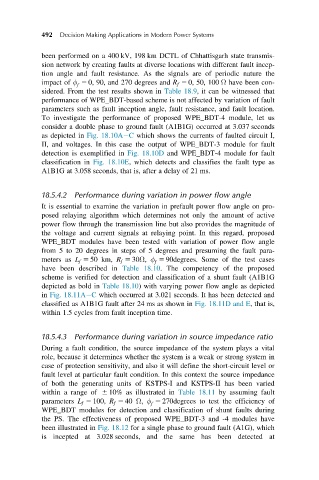Page 533 - Decision Making Applications in Modern Power Systems
P. 533
492 Decision Making Applications in Modern Power Systems
been performed on a 400 kV, 198 km DCTL of Chhattisgarh state transmis-
sion network by creating faults at diverse locations with different fault incep-
tion angle and fault resistance. As the signals are of periodic nature the
impact of φ 5 0, 90, and 270 degrees and R f 5 0, 50, 100 Ω have been con-
f
sidered. From the test results shown in Table 18.9, it can be witnessed that
performance of WPE_BDT-based scheme is not affected by variation of fault
parameters such as fault inception angle, fault resistance, and fault location.
To investigate the performance of proposed WPE_BDT-4 module, let us
consider a double phase to ground fault (A1B1G) occurred at 3.037 seconds
as depicted in Fig. 18.10A C which shows the currents of faulted circuit I,
II, and voltages. In this case the output of WPE_BDT-3 module for fault
detection is exemplified in Fig. 18.10D and WPE_BDT-4 module for fault
classification in Fig. 18.10E, which detects and classifies the fault type as
A1B1G at 3.058 seconds, that is, after a delay of 21 ms.
18.5.4.2 Performance during variation in power flow angle
It is essential to examine the variation in prefault power flow angle on pro-
posed relaying algorithm which determines not only the amount of active
power flow through the transmission line but also provides the magnitude of
the voltage and current signals at relaying point. In this regard, proposed
WPE_BDT modules have been tested with variation of power flow angle
from 5 to 20 degrees in steps of 5 degrees and presuming the fault para-
meters as L f 5 50 km, R f 5 30Ω, φ 5 90degrees. Some of the test cases
f
have been described in Table 18.10. The competency of the proposed
scheme is verified for detection and classification of a shunt fault (A1B1G
depicted as bold in Table 18.10) with varying power flow angle as depicted
in Fig. 18.11A C which occurred at 3.021 seconds. It has been detected and
classified as A1B1G fault after 24 ms as shown in Fig. 18.11D and E, that is,
within 1.5 cycles from fault inception time.
18.5.4.3 Performance during variation in source impedance ratio
During a fault condition, the source impedance of the system plays a vital
role, because it determines whether the system is a weak or strong system in
case of protection sensitivity, and also it will define the short-circuit level or
fault level at particular fault condition. In this context the source impedance
of both the generating units of KSTPS-I and KSTPS-II has been varied
within a range of 6 10% as illustrated in Table 18.11 by assuming fault
parameters L f 5 100, R f 5 40 Ω, φ 5 270degrees to test the efficiency of
f
WPE_BDT modules for detection and classification of shunt faults during
the PS. The effectiveness of proposed WPE_BDT-3 and -4 modules have
been illustrated in Fig. 18.12 for a single phase to ground fault (A1G), which
is incepted at 3.028 seconds, and the same has been detected at

